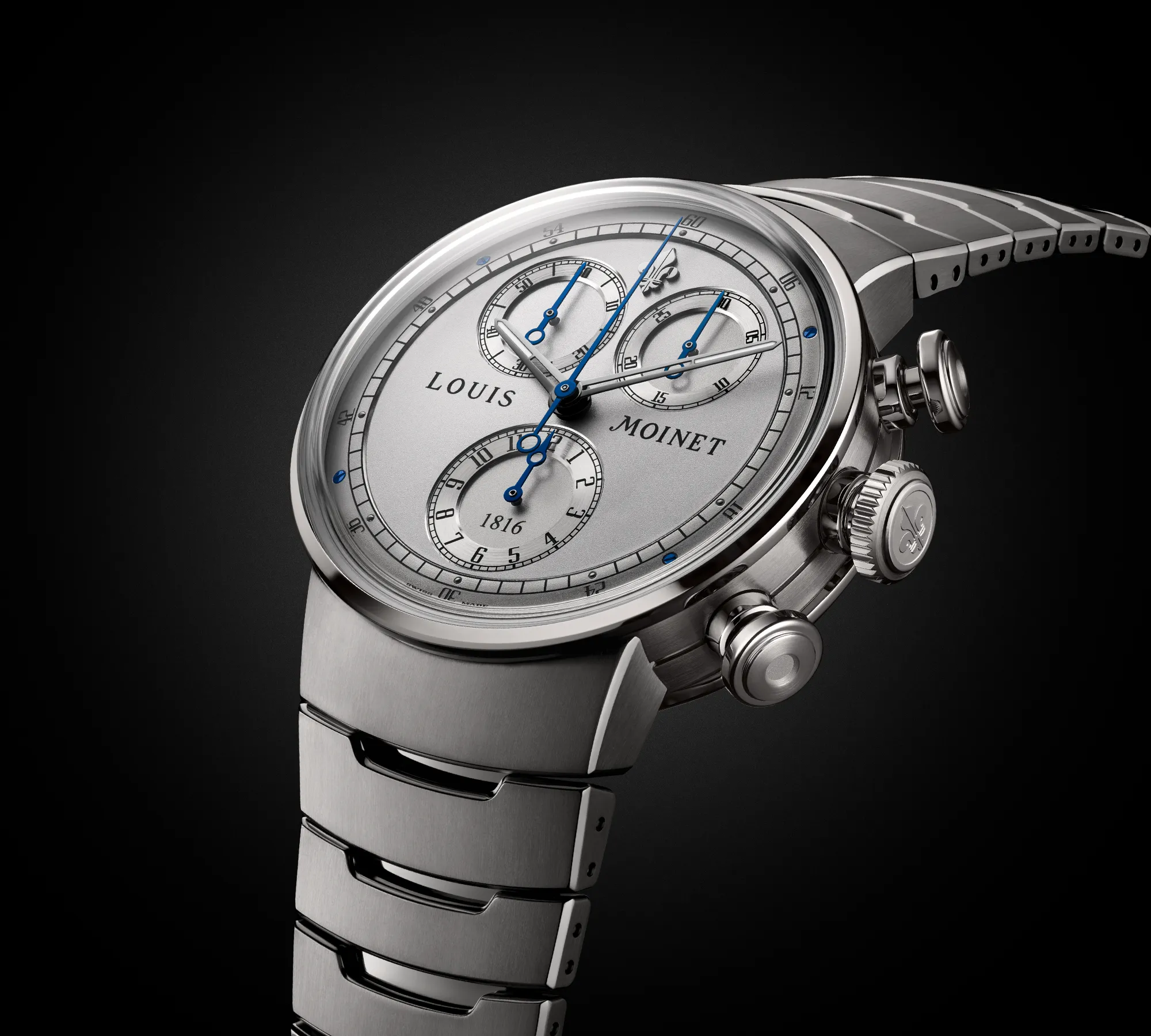Grade 5 titanium
LM-150.20.60
1816, an icon reborn
1816 was one of the major turning points in watchmaking history. It is the year in which the great watchmaker Louis Moinet completed the world's first chronograph.
Today, the 1816 made by Les Ateliers Louis Moinet shines the spotlight onto the legacy of this pivotal masterpiece. The watch remains true to the essence of its original model and is now ready to write the next chapter in its history.
Calibre LM1816
Chronograph, manufacture calibre
Manual
28800 VPH (4 Hz)
48 hours
Jewels: 34
40.6 mm
Hours, Minutes, Seconds, Chronograph

50 metres
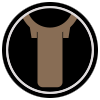
Grade 5 titanium
Folding clasp

Grade 5 titanium
Swiss made
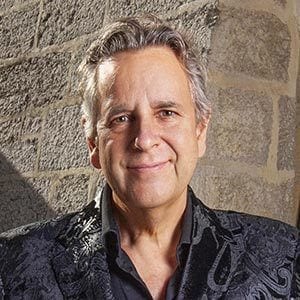
“Our roots are our future! And the 1816 is proof of this. Its originality and its sheer power carry the heritage of a pioneering work.”
Jean-Marie Schaller
CEO & Creative Director
Reinventing heritage
The 1816 chronograph
A closer look at Les Ateliers Louis Moinet’s new 1816 chronograph means taking a deep dive into over 200 years of history through a timepiece exhibiting a resolutely contemporary style. The DNA of Moinet’s compteur de tierces, which with its sober, functional, and, for its time, avant-garde design, emerges in every detail. The aesthetic codes of the original model have been given a totally new interpretation but one that is always in keeping with traditional haute horlogerie.
The double-gadroon case, in polished and satin-finished grade 5 titanium, measures 40.6 millimetres in diameter and is composed of 51 parts. It retains its original Directoire style semi-bassine design with a smooth case middle. Two sober pushers frame the winding crown, which is decorated with a fleur-de-lys, the emblem of Bourges, Louis Moinet's birthplace. The elegant and timeless 1816 was made to be very comfortable on the wrist.
The slightly vaulted dial is both legible and functional. The chronograph hand is clearly visible and shares space on the dial with two totalisers — one for the hours, the other for minutes — along with a small seconds subdial.
The whole is surrounded by a minute and seconds chapter divided in increments of six, recalling the original sixtieths of a second indication.
The hand-wound mechanism includes components specific to traditional watchmaking, such as an instantaneous minute counter, a column wheel, and swan-neck regulating spring.
The grade 5 titanium bracelet integrated into the case is the very first metallic bracelet developed by Les Ateliers Louis Moinet.
This truly contemporary bracelet exhibits a singular, unclassifiable design. It was conceived as a natural extension of the case. The progression of links articulates in a natural continuity, hugging the wrist while remaining perfectly balanced. Their dimension is underscored by satin and polished finishing, creating a sculptural whole that is both fluid and ergonomic.
Louis Moinet’s avant-garde vision
and the 1816 dial
From the end of the 18th century, as watch mechanisms became more precise, master watchmakers paid increasing attention to the aesthetics and legibility of their creations. Louis Moinet was no exception. The layout of the subsidiary counters on his compteur de tierces already anticipated the modern configuration of 20th-century chronographs. It established the perfect balance between functionality and design as a genuine measurement interface.
The contemporary version of the dial remains faithful to this functional architecture. It uses the same layout as that designed by Louis Moinet himself. The subsidiary dials for the small seconds and the 30-minute instantaneous totaliser are arranged horizontally on the top half of the dial on either side of the central chronograph hand. They overlook the 12-hour totaliser. The composition is well balanced, with each counter featuring a satin-brushed so-called annular dial with Arabic numerals. The same finishing is used for the minute scale, which is divided into increments of six minutes punctuated with ten blackened nickel cabochons.
Engraving has made it possible to precisely inscribe the dial markings, the name of the timepiece – 1816 – and the name Louis Moinet, reproduced in the typography of the original creation.
The central chronograph hand and the counters’ hands are out of blued steel. The hours and minutes are indicated by Louis Moinet-style openworked hands, with tips coated with a luminescent substance. Excellent readability is ensured thanks to the sharp contrast with the rhodium dial serving as a backdrop.
The entire dial is composed of twenty-three elements, including the ten cabochons. The centre of the totalisers, the flange, and the dial have been bead blasted. True to the original, the dial plate itself has been mounted onto the watch with four blued-steel screws.
The final touch is the fleur-de-lys logo at twelve o'clock. It pays homage to the city of Bourges, where Louis Moinet was born in 1768.
Louis Moinet was both an artist and a watchmaker. The aesthetics of the new 1816 chronograph reflect this dual talent. It is a sober, functional and powerful creation, conceived as an instrument in the service of time combining mechanical prowess and visual purity.

A new in-house, traditionally conceived calibre for the 1816

“The challenge when designing the 1816 was to preserve the quintessence of the original chronograph while integrating a movement that could meet all haute horlogerie standards. This entailed designing a fully integrated calibre, conceived from scratch.”
Jean-Marie Schaller
CEO & Creative Director
By the same token, the actual construction of the mechanism follows Louis Moinet's avant-garde vision of the watch, with a distinct architecture for the movement and dial. Ever since, watchmaking has been driven by such aspects as functionality and mechanical elegance, aesthetics and legibility. For the 1816 timepiece, this is reflected in a calibre composed of 330 parts including 34 jewels. It beats at 28,800 vibrations per hour and was developed exclusively for the 1816 chronograph so as to preserve the DNA of the “thirds counter,” the compteur de tierces, while adding a contemporary touch.
The absence of a plate on the back reveals the grand interplay of shaped parts, overlapping planes and bridges, concatenated cogs, and chronometric controls. The contrasts are striking: the white of the steel, the satin finish and brassy hue of the bridges, the blue of the fixing screws, and the deep red of the rubies.
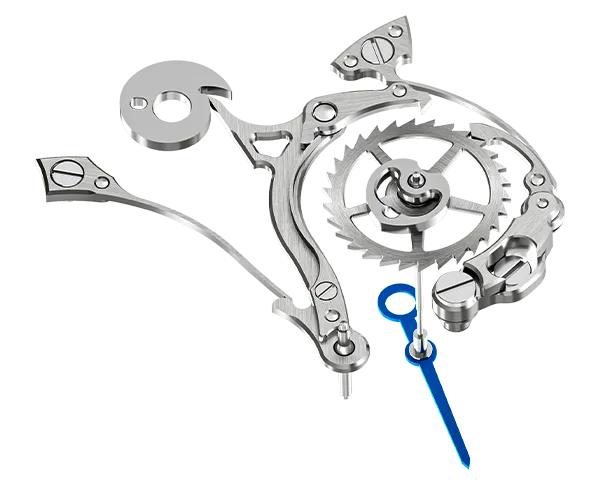
The instantaneous minute counter
prevents reading errors
The jumping minute counter precisely measures short intervals of time. Unlike a trailing counter, where the hand moves slowly and continuously, the jumping minute counter permits error-free reading since its hand jumps instantaneously from one gradation to the next at the sixtieth second. In other words, it displays the number of minutes elapsed directly and without scrolling. This enables time to be read off immediately. The hour counter, on the other hand, works in the traditional way, displaying the time as it passes sequentially.
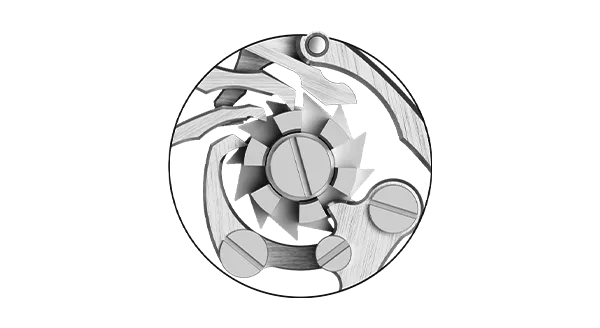
The column wheel
The special component of high-end chronographs
First used in 1878, the column wheel is a kind of ratchet wheel with six or nine triangular teeth or columns set at right angles to each other. It turns in one direction only and smoothly coordinates the start, stop, and reset phases of the chronograph.
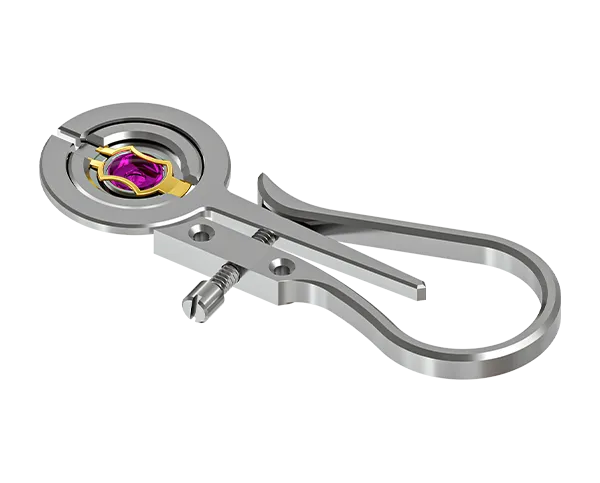
The swan-neck regulator
an ever-popular setting standard
The swan-neck regulator is a device consisting of a spring curved around the lever, which is acted upon by a micrometre screw allowing the fine adjustment of the watch’s rate. It was invented and patented in 1867 and is still highly prized for its sleek, elegant shape.



